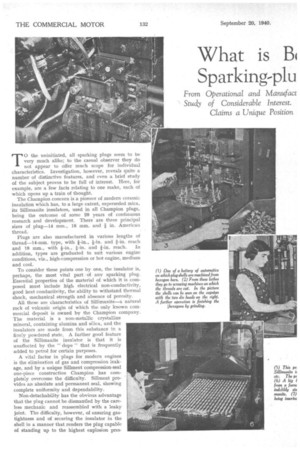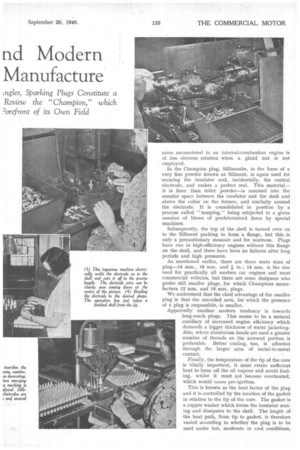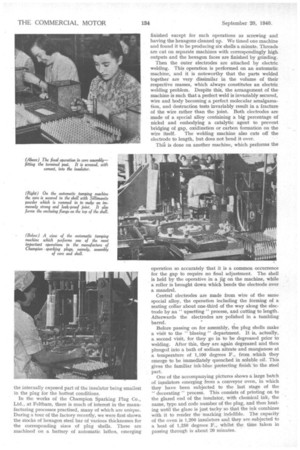What is B Sparking-plu rid Modern Manufacture
Page 30

Page 31

Page 32

Page 33

If you've noticed an error in this article please click here to report it so we can fix it.
From Operational and Manufact Study of Considerable Interest. Claims a Unique Position
,ngles, Sparking Plugs Constitute a Review the "Champion," which 7orefront of its Own Field T0 the uninitiated, all sparking plugs seem to be very much alike; to the casual observer they do not appear to offer much scope for individual characteristics. Investigation, however, reveals quite a number of distinctive features, and even a brief study of the subject proves to be full of interest. Here, for example, are a few facts relating to one make, each of which opens up a train of thought.
The Champion concern is a pioneer of modern ceramic insulation which has, to a large extent, superseded mica, its Sillimanite insulators, used in all Champion plugs, being the outcome of some 20 years of continuous research and development. There are three principal sizes of plug-14 mm., 18 mm. and i in. American thread.
Plugs are also manufactured in various lengths of thread-14-mm. type, with fin., Fin, and fin, reach and 18 mm., with Fin., fin. and fin. reach. In addition, types are graduated to suit various engine conditions, viz., high-compression or hot engine, medium and cool.
To consider these points one by one, the insulator is, perhaps, the most vital part of any sparking plug. Essential properties of the material of which it is composed must include high electrical non-conductivity, good heat conductivity, the ability to withstand thermal shock, mechanical strength and absence of porosity.
All these are characteristics of Sillimanite—a natural rock of volcanic origin of which the only known commercial deposit is owned by the Champion company. The material is a non-metallic crystalline mineral, containing alumina and silica, and the insulators are made from this substance in a finely powdered state. A further good feature of the Sillimanite insulator is that it is unaffected by the " dope " that is frequently added to petrol for certain purposes.
A vital factor in plugs for modern engines is the elimination of gas and compression leakage, and by a unique Sillment compression-seal one-piece construction Champion has completely overcome the difficulty. Sillrnent provides an absolute and permanent seal, showing complete uniformity and dependability.
Non-detachability has the obvious advantage that the plug cannot be dismantled by the careless mechanic and reassembled with a leaky joint. The difficulty, however, of ensuring gastightness and of securing the insulator in the shell in a manner that renders the plug capable of standing up to the highest explosion pres sures encountered in an internal-combustion engine is of less obvious solution when a gland nut is not • employed.
In the Champion plug, Sillimanite, in the form of a very fine powder known as Sillment, is again used for securing the insulator and, incidentally, the central electrode, and makes a perfect seal. This material— it is finer than toilet powder—is rammed into the annular space between the insulator and the shell and above the collar on the former, and similarly around the electrode. It is consolidated in position by a process called "tamping," being subjected to a given number of blows of predetermined force by special machines.
Subsequently, the top of the shell is turned over on to the Sillment packing to form a flange, but this is only a precautionary measure and for neatness. Plugs have run in high-efficiency engines without this flange on the shell, and there have been no failures after long periods and high pressures.
As mentioned earlier, there are three main sizes of plug-14 ram., 18 mm. and in.; 14 mm. is the size used for practically all modern car engines and most commercial vehicles, but there are some designers who prefer still smaller plugs, for which Champions manufacture 12 mm. and 10 mm. plugs.
We understand that the chief advantage of the smaller plug is that the uncooled area, for which the presence of a plug is responsible, is smaller.
Apparently another modern tendency is towards long-reach plugs. This seems to be a natural corollary of increased engine efficiency which demands a bigger thickness of water jacketing_ Also, where aluminium heads are used a greater number of threads on the screwed portion is preferable. Better cooling, too, is afforded through the larger area of metal-to-metal contact.
Finally, the temperature of the tip of the core is vitally important, it must retain sufficient heat to burn off the oil vapour and avoid fouling, whilst it must not become overheated, which would cause pre-ignition.
This is known as the heat factor of the plug and it is controlled by the location of the gasket in relation to the tip of the core. The gasket is a copper washer which forms the insulator seating and dissipates to the shell. The length of the heat path, from tip to gasket, is therefore varied according to whether the plug is to be used under hot, moderate or cool conditions,
the internally exposed part of the insulator being smallest in the plug for the hottest conditions.
In the works of the Champion Sparking Plug Co., Ltd., at Feltham, there is much of interest in the manufacturing processes practised, many of which are unique. During a tour of the factory recently, we were first shown the stocks of hexagon steel bar of various thicknesses for the corresponding sizes of plug shells. These are machined on a battery of automatic lathes, emerging
finished except for such operations as screwing and having the hexagons cleaned up. We timed one machine and found it to be producing six shells a minute. Threads are cut on separate machines with correspondingly high outputs and the hexagon faces are finished by grinding.
Then the outer electrodes are attached by electric welding. This operation is performed on an automatic machine, and it is noteworthy that the parts welded together are very dissimilar in the volume of their respective masses, which always constitutes an electric welding problem. Despite this, the arrangement of the machine is such that a perfect weld is invariably secured, wire and body becoming a perfect molecular amalgamation, and destruction tests invariably result in a fracture of the wire rather than the joint. Both electrodes are made of a special alloy containing a big percentage of nickel and embodying a catalytic agent to prevent bridging of gap, oxidization or carbon formation on the
wire itself. The welding machine also cuts off the electrode to length, but does not bend it over.
Thi; is done on another machine, which performs the operation so accurately that it is a common occurrence for the gap to require no final adjustment. The shell is held by the operative in a jig on the machine, while a roller is brought down which bends the electrode over a mandrel.
Central electrodes are made from wire of the same special alloy, the operation including the forming of a seating collar about one-third of the way along the electrode by an " upsetting "process, and cutting to length. Afterwards the electrodes are polished in a tumbling barrel.
Before passing on for assembly, the plug shells make a visit to the " blueing " department. It is, actually, a second visit, for they go in to be degreased prior to welding. After this, they are again degreased and then plunged into a bath of sodium nitrate and manganese at a temperature of 1,100 degrees F., from which they emerge to be immediately quenched in soluble oil. This gives the familiar ink-blue protecting finish to the steel part.
One of the accompanying pictures shows a large batch of insulators emerging from a conveyor oven, in which they have been subjected to the last stage of the " decorating " process. This consists of printing on to the glazed end of the insulator, with chemical ink, the name, type and code number of the plug, and then heating until the glaze is just tacky so that the ink combines with it -to render the 'marking indelible. The capacity of the oven is 1,200 insulators and they are subjected to a beat of 1,250 degrees F., whilst the time taken in passing through is about 20 minutes.
Inserting the central electrode is the first assembling operation. It is entered from the top of the insulator and the collar rests on a seating in the bore, which, of course, locates it. Then Sillment powder, so fine that it will pass through a screen with a mesh of 130,000 holes to the square inch, is introduced and 'tamped "by means of a tamping tool of hollow cylindrical shape. This holds it absolutely secure and makes a leak-proof joint. Subsequently a terminal post is screwed into the insulator, a thread being cast on the bore of this to receive it. It is inserted with a cement composed of Sillment powder and a bonding material.
Final assembly of core and shell is carried out on an automatic tamping machine, which incorporates a rotating platform having the plugs arranged around it. An operative places the cores and copper seating gaskets in the shells and puts on each a cup to guide the powder into the annular space. This is fed in in a predetermined quantity. The next operation as the platform turns is ramming or tamping; then more powder and more tamping. Next a grab descends and lifts off the cup and, after this, a mechanical finger checks the level of the powder. If the quantity be found by it to be insufficient, the machine is automatically stopped.
At the next stage a " reamer " cleans surplus powder away from the joint, which operation is done in a suction chamber, the dust being carried off through a conduit. Finally, a tool turns over the flange.
About 500 plugs are produced per hour per machine and all are tested under a pressure of 150 lb. per sq. in. The importance of ensuring that a plug is leak proof is evidenced by the fact that a leak of 5 c.c. will result in a local temperature rise of 30-50 degrees F. A. claim of the Champion company is that non-detachable plugs can be made more leak proof than the two-piece type, also that the ceramic type reduces the number of models required for a comprehensive operating range. It was early in the century that the first Champion sparking plug was produced, and now 80,000,000 are made annually. The plug represents a combination of engineering and ceramics culminating from decades of research and experience.




























































